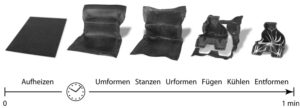Thermoplastic Composites

| Process Sequence of the In-Mould Forming Process |
Many applications demand a reduction of part weights to increase the performance in use. In automotive applications the reduction of fuel consumption is a main goal while in sporting goods the increase of comfort is the focus. The decreasing size of mobile phones, smartphones and laptops also demands filigree and thin-walled constructions with high requirements for the mechanical properties.
Since the focus of the research and development of composites at the LKT lies in the area of high-volume production, mainly thermoplastic composites that are intended for high-volume production are used because of their formability in short cycles. The possibility to combine different fiber and matrix materials allows for a wide range of composites that can be used for varied applications with varying demands. The fibers can be short, long or endless for reinforcement purposes. Thermoplasts reinforced with endless fibers are so called organo-sheets.
Aside from the characterization of commercially available semi-finished products, producing semi-finished products with custom, individual properties not yet available is part of the research at the LKT. Thereby, new areas of application and a deeper understanding of the engagement with the following shaping process shall be achieved.
Based on the traditional “hybrid-technique” new processes have been developed that combine constructional and processing techniques in a new way. In this regard, shaping organo-sheets, which can be carried out in many different ways, is combined with the highly successful injection molding technique in one process cycle. This way lightweight design through construction is even more possible than pure lightweight design through materials. Furthermore entirely new processes are being developed at the LKT. For example, fluid pressure is used for shaping instead of a stamp, which enables the production of hollow bodies with injection molding.
Dr.-Ing. Uta Rösel
Institute of Polymer Technology
Processing (Head of Department)
- Phone number: +49913185-71002
- Email: uta.ur.roesel@fau.de
